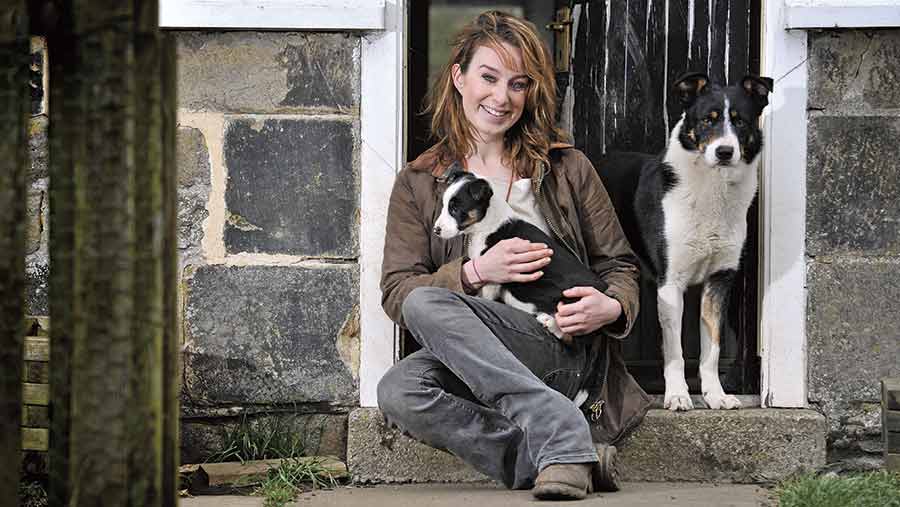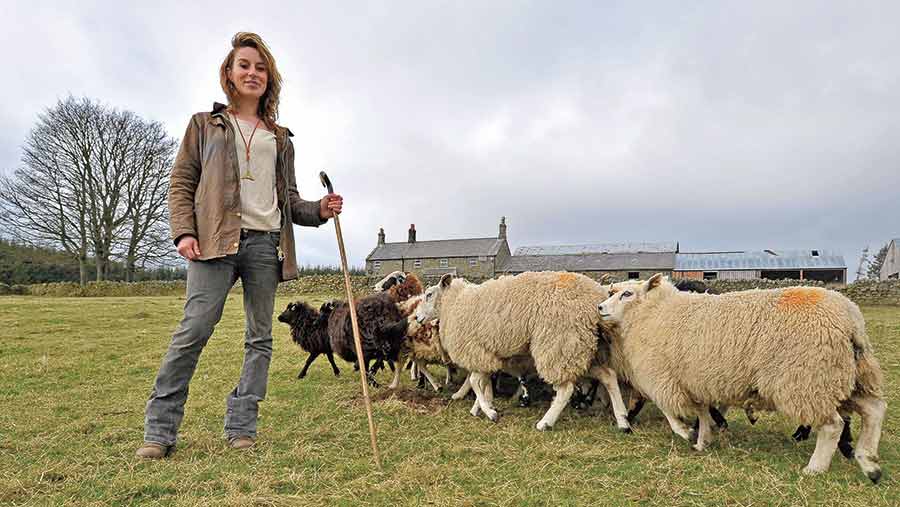TV star’s top tips on training a sheepdog

© Bruce-Adams-Daily-Mail-Rex-Shutterstock
Training a sheepdog may be a lot of work, but it does develop a closer bond between the farmer and their four-legged friend. Farmers Weekly spoke to dog trainer and mentor on the TV show Flockstars, Emma Gray.
Don’t expect too much too soon and spend plenty of time with a youngster to help develop a close bond between the dog and handler before any proper work with sheep is even considered.
That’s the advice of Northumberland sheepdog trainer Emma Gray, who says even though a young sheepdog pup may seem keen and want to work it’s important to have a structure and a plan to its training.
“Just for convenience a lot of farmers will take a keen youngster out with them on the basis that the dog will teach itself to work with sheep. But it’s like putting a child that can’t swim into a swimming pool.
See also: The farmer’s best friend: Which sheepdog breed to choose
Stage-by-stage guide to keeping your pup’s progress on track:
- Up to around seven months – let them be “puppies”, build up a bond with the youngster, teach manners and become accustomed to people and gain confidence
- Up to 12-months – start initial stages of training, introduce to small group of “easy” sheep to allow natural instincts to develop, start work on the “lie down” keep training sessions short, avoid any bad experiences with difficult sheep
- From 12-18-months – allow the dog to start working further away at up to 500 yards, encourage the dog to start driving and learning to bring sheep towards the handler, allow the dog to gradually develop confidence in its work
“A young dog has to have learned the basic understanding of moving left and right and to stop before it’s allowed to do any real work. This must be done carefully over many months and with training on calm sheep.
“You can’t start shouting commands at a dog when it hasn’t been taught what they mean.
“So real patience is needed. If training takes a bit longer because you need to more time to teach the dog, you will reap the benefits later. “
Young pups need only short periods of training in the early stages, say five to 10 minutes a day.
“A young pup should learn to come back to its name and to lie down on command and to walk on a lead. But most importantly allow the pup the freedom to fully develop and experience as many things as possible such as different people, vehicles and noises.”

© Bruce-Adams-Daily-Mail-Rex-Shutterstock
Don’t train a pup too young
Emma says she likes to see a young six to eight-month-old pup show a keen interest in sheep, but urges handlers to wait until a dog is physically mature and able to outpace sheep before formal training starts at around 10-14 months.
“It’s very important for youngsters to enjoy their youth and not be pressured into early training. I like puppies to be puppies. They need time spending with them to become responsive to you and to learn good manners.
“Don’t just leave a youngster in its kennel until it’s eight months old and then expect it to start to have a good working relationship with you.”
Emma believes too many young dogs are trained too early. “It’s amazing how faster they learn and how much better they are at their job if they are left to mature mentally and physically.
“Farmers see dogs competing at trials at under a year old and assume that’s the norm for every sheepdog.”
Do:
- Train pups for 5-10 minutes each day
- Start training on a small batch of quiet sheep
- Use a long line so dogs can be stopped
- Use a “clock face” to keep positions
- Let young dogs build their confidence gradually
- Avoid confrontational situations
Don’t:
- Start formal training until a dog is 10-14 months of age
- Start training a big paddock. Use a yard or a smaller one to start
- Don’t over challenge young dogs
What to do when you start training
Emma suggests training should start by introducing a young dog to a batch of six to 10 quiet hoggs or ewes without lambs.
“It’s worth having a long line on a young dog to start with so that any unruly behaviour can be easily stopped.
“The dog should naturally want to run around the sheep so make sure you are at the 6 o’clock position in relation to the dog’s 12 o’clock position, with the sheep occupying the centre of the clock.
“If you move to your right the dog should counter by moving to his right to balance the sheep, which means he is always at 12 o’clock to your 6 o’clock. As you move and he moves to balance that, you can give the command “away” which means move anticlockwise around the sheep.
“As you move to the left, and the dog balances with a left movement, you give the command “come bye”, meaning move clockwise.”
Emma says a dog will gradually start to associate the command with the movement and will move without the handler having to alter position.
“When this is really well established you can start sending your dog further to gather the sheep but don’t rush things or expect the dog to do more than it’s capable of.”
Questions & Answers
Q. My old dog was difficult to stop, how do I get it right with my youngster?
A. Some handlers struggle to get a young dog to stop and it can end-up being a life-long problem. Make sure you teach this in the early stages in a confined space, say a yard or paddock. If you can’t get it right in this situation you will never achieve it when the dog is working sheep in open spaces.
Q. How do train a dog that is too keen?
A. With an over keen dog let it run off some steam alongside a quad bike before training or give it a run around some training sheep before taking it to work. And in the early days don’t over-face a young dog. For example, don’t expect it to deal with a grumpy old ewe when he is just learning the ropes.
A bad experience in the early days can turn a dog into a coward for life, whereas if his confidence is gradually built he will take on whatever you ask him to.
Q. Some youngsters can be sensitive, so how do I build confidence?
A. Success breeds success so allow a sensitive pup to succeed in the very early lessons. Avoid confrontational situations or anything that may potentially unnerve the pup. All this will help in its later education. So always send the dog to gather sheep in simple places to start with and gradually build up to more testing situations.
Have you got any tips for training sheepdogs? Perhaps you’ve had previous experience at what has worked well or it could be a trick passed down through the generations. If so we would love to hear from you. Send your thoughts to rhian.price@rbi.co.uk
